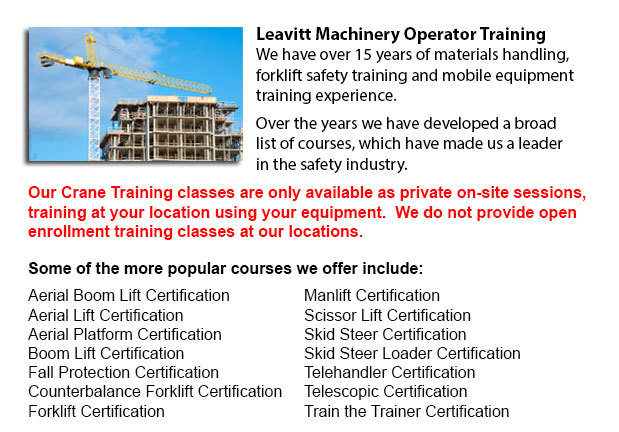
London Overhead Crane Safety Training - The overhead crane safety training course is intended to equip the operators with the right skills and knowledge in the areas of: crane safety precautions, accident avoidance, materials handling, and equipment and stock protection. Each of the trainees will get to learn about numerous types of overhead cranes, their capabilities and their uses in different settings. For operators who are licensed and trained, the shift in liability moves from the company to the operator. Therefore, the program emphasizes individual operator responsibilities.
The operators in the overhead safety training course would be given instruction about the right methods for carrying out checks: the more detailed in-depth inspection and the pre-shift inspection. These are critical daily routines which should be logged. Correctly recorded pre-shift inspections help to protect the company from liability in case of an accident. Pre-shift inspections also prevent expensive repairs, accidents and damage. Operators learn how to designate a specific individual to carry out inspections, how to report problems, and how to maintain the log book.
Every inspection should be documented and carried out regularly. Things which should be inspected for possible problems, comprise: hooks for cracks, increases in the throat opening, degree of twist; hoist ropes for corrosion, loss of diameter, worn wires, kinks and bird caging, broken wires, chains for gouges and nicks, heat and chemical damage, corrosion and cracks, twists, excessive wear, distortion, pits, stretching, damage from extreme heat.
Operators learn correct rigging measures in this program. Rigging includes understanding the manufacturer's data plate, determining the material weight to be lifted, choosing the gear, and utilizing safe practices to secure the load. The course include in detail the following: safe working loads, and the capacities of ropes, chains, hooks, shackles and slings.
It is important to know who may utilize the cranes at your facility, physical requirements of the job, and operator credentials needed for permits and specialized job. Safety is a priority when utilizing near pedestrian traffic.
The responsibilities included in the safe crane use includes checking for hydraulic leaks, undertaking visual inspections, checking the safety guards, testing the controls, examining the hook and hoist rope, braking mechanisms and limit switches. Proper reporting procedures are critical. These topics are all covered in depth in the course.
The program likewise covers the right lifting and moving procedures with cranes and hoists. Operators would likewise learn proper hand signals. Training involves how to raise the load, attach the load, unhook the slings, abort a lift and set the load.
The steps included with moving the load, consists of: starting and stopping procedures, controlling and guiding the load, observing working conditions and working with signals. In the event of power failures, the operator would have to know how to proceed. The program covers techniques for removing the slings and lowering the load, storage of equipment, parking the crane, and securing an outdoor and indoor crane.
-
London Crane License
London Crane License - Crane operators ought to be "credentialed", that means they must possess a crane operator license or certification. Credentialing is considered a mandatory governmental requirement in order to practice as a crane operator. Obta... More -
London Heavy Equipment Operator Training
London Heavy Equipment Operator Training - Training facilities which offer quality standards in the industry and not just provide field performing tasks but added equipment training are highly sought after. Accredited schools provide students the kno... More -
Telehandler Training in London
Telescopic handlers usually referred to as telehandlers for short, are a very popular piece of heavy construction machinery. They are usually utilized in the agriculture and construction industries. These machines have maximum reaching capacity and c... More -
London Boom Lift Certification
London Boom Lift Certification - Elevated work platforms allow maintenance operations and work to be carried out at heights which could not be reached by any other means. Workers utilizing boom lifts and scissor lifts can learn how to safely operate... More -
London Fall Protection Ticket
London Fall Protection Ticket - Fall-related accidents are the number one reason of death within the construction industry. The potential for fall incidents really increases based upon the kind of work that is being completed within your workplace. T... More -
London Forklift Safety Training
London Forklift Safety Training - Anybody who wants to operate a lift truck should take a forklift safety training program to become a certified forklift truck operator. There are several ways to obtain forklift training. Programs are provided throug... More -
Operator Safety Training, Re-Qualification Training, In-House Instructor Training in London
Lift trucks are used in nearly all warehouse operations and in boat yards and in industrial construction sites. The reach feature of a forklift is a vital component used in various applications like for instance whenever a shelving system is being us... More -
London Boom Lift Safety Training
London Boom Lift Safey Training - Boom lifts are a type of elevated work platform or aerial lifting device that are commonly utilized in construction, industry, and warehousing. Boom lifts can be used in practically any surroundings due to their vers... More

Forklift Certification London
TOLL FREE: 1-888-254-6157
London, Ontario
forkliftcertificationlondon.com
Email Us
About Us


